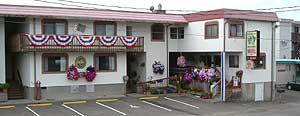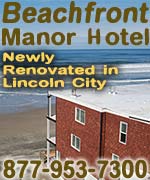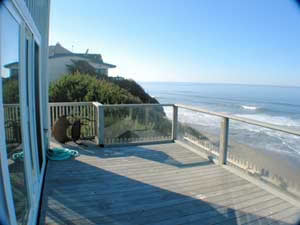 |
Treasures, Shipwrecks Create Huge Publicity for Oregon Coast |
|---|
Covering 180 miles of Oregon coast travel: Astoria, Seaside, Cannon Beach, Manzanita, Nehalem, Wheeler, Rockaway, Garibaldi, Tillamook, Oceanside, Pacific City, Lincoln City, Depoe Bay, Newport, Waldport, Yachats & Florence.
03/11/08
Secrets of the Season |
Treasures, Shipwrecks Create Huge Publicity for Oregon Coast
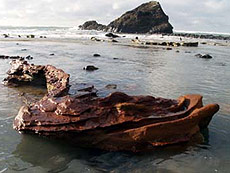 |
| Red towers at Arch Cape, a geologic oddity caused by compacted iron deposits beneath the sand, are a sizable attraction on the coast right now. (photo Tiffany Boothe, Seaside Aquarium) |
(Oregon Coast) – It may be the biggest chunk of press the Oregon coast received since Keiko the Whale or the New Carissa shipwreck debacle in the 90’s. Some say it even eclipsed the coverage of last December’s crippling storm – coverage which managed to damage the image of the coast among potential tourists, who stayed away for two months after the worst was over.
The discovery of the two historically significant cannon, the shipwrecks on the southern Oregon coast and the run of emerging ghost forests and geologic oddities unearthed by low sand levels sent the media into a frenzy in late February, with heavy coverage locally, but also extensive stories done around the U.S. and abroad.
It hasn’t resulted in a flood of visitors to the coast recently, but it has made a difference. Tourism entities and businesses on the north coast report a sometimes-significant spike in phone calls and visitors asking about some of the wild stuff found recently. Some of the beaches that host this stuff – like Hug Point and Arch Cape – have seen increased traffic. The shipwreck near Coos Bay long ago started causing traffic problems, even though it’s a six-mile hike to the wreck that has emerged from a sandy cliff.
 |
| Coos Bay shipwreck (photo Boothe) |
The ghost forests that line the beaches of the Newport area have seen a slight bump in visitors as well.
All that after endless front page coverage on Oregon and Washington newspapers of these various events, and Portland-area TV and radio ran some of these as their top stories for a few days. But even more importantly, these stories were greatly syndicated all over the U.S. and the world, across an endless array of websites, and in a wide variety of publications outside the U.S.
“People are really excited about all this,” said Kim Bosse, director of the Cannon Beach Chamber, which fielded the most calls from visitors about the cannon discoveries.
Weiss' Paradise Suites & Vacation Rentals - Seaside Unique Luxury Accommodations in Seaside. 1BR Suites,
1BR & 2BR Duplex Units and 3BR Houses, units for 2-8 people.
Rent entire property for 20-26. Close to beach, river and Broadway
St. |
And it couldn’t come at a better time. After the December ’07 storm, the power was out for five days on the north coast, but the central coast was back to normal within a day or two. Roads were open almost immediately. The tourism industry on the coast took a heavy hit – financially more disastrous than the storm itself, as people were still asking a month and a half later if roads were open to the coast. A strong ski season also took a lot of attention away from the beaches, as did bad snowy conditions on the passes to the coast.
 |
| Cannon found at Arch Cape (photo Boothe) |
December and January were an economic mess for the Oregon coast. It had PR firms for towns like Astoria and Seaside Tourism Director Mikaela Norval shooting out press releases reminding the press and the public that the “coast is open for business.”
Ironically, those same storms that lashed the shore and downed trees in massive numbers also sucked out lots of sand from the beaches, resulting in the amazing finds that have popped up.
Norval and others at the Seaside Visitor Center said they’ve received a few calls asking about the location of various discoveries on the north coast.
Bosse’ said the big flurry came just after the cannon were discovered. They’re probably from the USS Shark – the ship whose first cannon gave the town its name - and more than 150 years old.
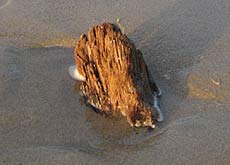 |
| Ancient ghost forest stump near Cape Kiwanda |
“We got about 20 emails and calls a day for the first few days after the story broke,” Bosse’ said.
Sharon Visser, who works at the front desk of the visitor center, said she fielded many calls and emails from people who wanted to see the cannon. “I had to explain they’re not open for viewing right now.”
The cannon are sitting at an Oregon State Parks and Recreation facility as researchers are working to keep them preserved.
“I think it’s great, all this coverage,” said Keith Chandler, manager of Seaside Aquarium. “It’s really good that we enlighten everyone on this, all around the world. But I wouldn’t say it’s bigger coverage than the storm, however, because we were getting calls from all over the U.S. asking if we were alright. Some people thought we were dead.”
 |
| Stumps south of Newport (photo Guy DiTorrice) |
Chandler reports fielding a few dozen calls himself on the subject, and he’s not even sure how many more other employees at the aquarium have had to answer on the subject. “I’ve seen more locals out on the beaches, looking for stuff,” he said. “We had somebody stop by from New York to look for these things. They were staying in Portland, but decided to drive out here to see this stuff after reading about it.”
At the Cannon Beach Historical Society, where the original cannon that was found in 1898 is on display, program director Tricia Gates Brown said there was some sizable increase in media activity at the museum and with visitors.
“On the first day the story broke, I was interviewed on TV,” Brown said. “And we did notice a sizable uptick in visitors in the first week or two. But we’re not sure how much of that is the spring weather and just more people come out later in the year. I would say it’s about twice the amount of visitors as normal for the last couple weeks.”
 |
| Red towers at Hug Point |
Seaside Aquarium had some of the biggest national and international exposure because of the ghost forests and the geologic oddities called “red towers.” One Associated Press story was syndicated in what appears to be more than 200 news outlets around the world, where the aquarium’s Tiffany Boothe was quoted extensively talking about the ghost forests of the north coast and the red towers.
That article also highlighted the cannon and the shipwrecks on the south coast.
|
The Ocean Lodge. There will not be another property built like this in Cannon Beach in our lifetimes. Rare, premiere ocean front location; handsome, dramatic architecture and tasteful, fun (nostalgic) beach interiors. Overlooks Haystack Rock. 100 percent smoke free. Imaginative special occasion packages. Massive wood burning lobby fireplace. Library w/ fireplace, stocked with impressive book collection. Pet and family friendly. Lavish continental buffet breakfast. In-room fireplaces, mini-kitchens. Jacuzzi tubs in select rooms. DVD players, complimentary movies. Morning paper. Warm cookies. 888-777-4047. 503-436-2241. 2864 Pacific Street. Cannon Beach, Oregon. www.theoceanlodge.com |
Then, press often begets press, and NPR interviewed Boothe on the subject as well – a story which also ran online.
 |
| Ghost forest at Neskowin |
BeachConnection.net staff reports seeing more people than usual for this time of year at Hug Point and the north end of Arch Cape. One group from Washington asked staff for directions to the ghost forest, saying they’d heard about them on NPR.
The result was the tiny town of Arch Cape and more well known Cannon Beach getting national and international exposure. It helped put tiny Arch Cape on the map as never before.
Barbara Dau, owner of Arch Cape House in the village, was among several lodging owners who kept hoping the phones might start ringing off the hook after such a disastrous winter. The surge in publicity didn’t seem to help immediately, but it now seems to be percolating.
“Some of my guests this past weekend were looking for the ghost forests,” Dau said.
 |
A1 Beach Rentals, Lincoln City. Perfect for large family vacations all the way down to a getaway lodging for two - with over 25 vacation rental homes to choose from. A breathtaking collection of craftsman or traditional beachfront homes, or oceanview houses – from one to seven bedrooms. In various areas of Lincoln City and overlooking the beach, with some in Depoe Bay. All kinds of amenities are available, like hot tubs, decks, BBQ, rock fireplaces, beamed ceilings and more. Some are new, some are historic charmers. Lincoln City, Oregon. 1-(503)-232-5984. www.a1beachrentals.com. |
|
Tradewinds Motel, Rockaway Beach. All rooms are immaculate and have TV’s, VCR’s and in-room phones w/ data ports. Oceanfronts have queen bed, a double hide-a-bed, kitchen, cozy firelog fireplace and private deck. Both types sleep up to four people. Others are appointed for a two-person romantic getaway, yet still perfect for those on a budget. Elaborate oceanfront Jacuzzi suite has two bedrooms, kitchen, double hide-a-bed, fireplace and private deck, sleeping as many as six. For family reunions or large gatherings such as weddings, some rooms can connect to create two-room and three-room suites. Some rooms pet friendly. 523 N. Pacific St., Rockaway Beach. (503) 355-2112 - 1-800-824-0938. www.tradewinds-motel.com |
 |
 Inn
at Cannon Beach. Beautifully wooded natural setting at quiet south
end of Cannon Beach. Great during winter storms with a new book by
the fireplace – or when the sun is out for family fun and beach
strolling. Handsome beach cottage-style architecture. Lush flowering
gardens and naturalized courtyard pond. Warm, inviting guest rooms.
Continental buffet breakfast. Warm Cookies. Family and Pet Friendly.
Welcome gifts. Smoke-free. Complimentary Wireless Connectivity. Wine
and book signing events. 800-321-6304 or 503-436-9085. Hemlock At
Surfcrest, Cannon Beach, Oregon. www.atcannonbeach.com. Inn
at Cannon Beach. Beautifully wooded natural setting at quiet south
end of Cannon Beach. Great during winter storms with a new book by
the fireplace – or when the sun is out for family fun and beach
strolling. Handsome beach cottage-style architecture. Lush flowering
gardens and naturalized courtyard pond. Warm, inviting guest rooms.
Continental buffet breakfast. Warm Cookies. Family and Pet Friendly.
Welcome gifts. Smoke-free. Complimentary Wireless Connectivity. Wine
and book signing events. 800-321-6304 or 503-436-9085. Hemlock At
Surfcrest, Cannon Beach, Oregon. www.atcannonbeach.com. |
|
Arch
Cape Property Services.
Dozens of homes in that dreamy,
rugged stretch between Cannon Beach and Manzanita known as Arch
Cape. Oceanfront and ocean view , or just a short walk from the
sea. |
Lincoln City Vacation Homes Something for everyone: smaller homes with a view to a large house that sleeps 15. All are either oceanfront or just a few steps away – all with a low bank access and fantastic views. Most are in the Nelscott area; one is close to the casino. You’ll find a variety of goodies: fireplaces, multiple bedrooms, dishwashers, Jacuzzis, washer/dryers, hot tubs, cable TV, VCR, barbecues; there’s a loft in one, and another sprawling home has two apartments. Pets allowed in some homes – ask first. Each comes with complete kitchens. Most have seventh night free. Prices range from winter $85 to summer $230 per night. www.getaway2thecoast.com. 541-994-8778. |
RELATED STORIES
Click here for video of Dec. storm aftermath
Oregon Coast Best of Awards for the Year And the winners are: best of Oregon coast restaurants, lodgings, science, odd events in nature and stunning moments for 2007
Watching Transformations of Oregon Coast Beaches Seasons change and so do beaches, revealing different sides and a variety of eye-popping sights
Staggeringly Cool Ideas for Oregon Coast Romance Be it the season of Valentine's or be it any time of the year, Oregon's coastline has essentially cornered the market for cuddle-inducing possibilities and gushy activities for the hand-holding set
Day or Night Mysteries and Merriment on Oregon Coast It's more than just nightlife that comes to life, but the beaches offer major opportunities
Oregon Coast Travel Site Goes Wireless Provides Lodging Reports - Oregon Coast Beach Connection now has mobile lodging and dining listings, along with weekly lodging availability reports














